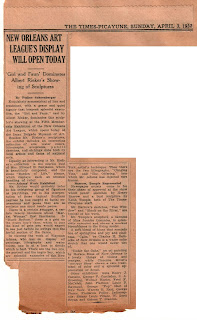In a few days time I will be going to Scotland with my husband for 17 days for our 5th wedding anniversary. The knowledge of this and the length of time I have been gone has led some urgency to preparations/trying to get as much work done as possible. I may or may not have already mentioned that I've refined my scanning technique such that I can capture up to three articles per scan, and then just use the crop and cover functions in MSPaint to really speed up the process, and I have--I can now get up to four pages of scrapbook done in a 3 hour session, and succeeded at six this past Friday.
Previously, Sheila expressed a desire for she, Maureen, Regina and I to get together and formally go over the current project protocols and maybe get a unified sense of all the components between the four of us, particularly the Subjects field--its necessity and the requirements for completing it, both in terms of time and skills. We weren't able to find a time, but I tried to collect my thoughts and disseminate the information via e-mail before I go:
"I know we can't all meet today, but I have updated the document "SCANNING NOMA NEWSPAPER ARTICLES" and saved it to all three platforms. It is also attached to this e-mail. Clear outlines of procedure for the new spreadsheet fields are included in the metadata section, which is what has changed primarily. Future interns with Excel experience will have clear instructions for what to enter in all fields, and future interns without such experience will have clear instructions for every other aspect of the project.
Previously, Sheila expressed a desire for she, Maureen, Regina and I to get together and formally go over the current project protocols and maybe get a unified sense of all the components between the four of us, particularly the Subjects field--its necessity and the requirements for completing it, both in terms of time and skills. We weren't able to find a time, but I tried to collect my thoughts and disseminate the information via e-mail before I go:
"I know we can't all meet today, but I have updated the document "SCANNING NOMA NEWSPAPER ARTICLES" and saved it to all three platforms. It is also attached to this e-mail. Clear outlines of procedure for the new spreadsheet fields are included in the metadata section, which is what has changed primarily. Future interns with Excel experience will have clear instructions for what to enter in all fields, and future interns without such experience will have clear instructions for every other aspect of the project.
The 'Subject' field in particular now has instructions indicating that it can either be addressed or skipped depending on the intern's prior experience with subject cataloging and CONTENTdm. If the intern is not comfortable or experienced with cataloging, it can be skipped. But if the intern does have cataloging experience and would like to add subjects, there are clear instructions on what controlled vocabulary sources to consult, and also to look at Regina's Finding Aid for local subjects.
I want to emphasize both how completely optional 'Subject' is, and how awesome a feature it will be if/when the project moves to the Louisiana Digital Library (LDL). I genuinely think allowing future interns the option of filling it in is worthwhile. Subjects are not required and never will be, but if the collection ends up in LDL and a browsing user can click on "Degas, Edgar, 1834-1917" and see all the articles from the scrapbooks that feature him, (which is what entering subjects into the spreadsheet will facilitate) it will be super helpful and cool!"
Unfortunately, it doesn't look like any of us will be able to start tackling the Subjects field before our internship time is up, but hopefully the document revisions are leading to clear instructions for a future intern who can.
Unfortunately, it doesn't look like any of us will be able to start tackling the Subjects field before our internship time is up, but hopefully the document revisions are leading to clear instructions for a future intern who can.
